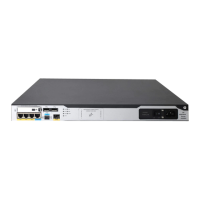14
Figure 11 IGMP snooping related ports
The following describes the ports involved in IGMP snooping:
• Router port—Layer 3 multicast device-side port. Layer 3 multicast devices include DRs and IGMP
queriers. In Figure 11, Gi
gabitEthernet 1/0/1 of Switch A and GigabitEthernet 1/0/1 of Switch B
are the router ports. A Layer 2 device records all its router ports in a router port list.
Do not confuse the "router port" in IGMP snooping with the "routed interface" commonly known as
the "Layer 3 interface." The router port in IGMP snooping is a Layer 2 interface.
• Member port—Multicast receiver-side port. In Figure 11, Gi
gabitEthernet 1/0/2 and
GigabitEthernet 1/0/3 of Switch A and GigabitEthernet 1/0/2 of Switch B are the member ports.
A Layer 2 device records all its member ports in the IGMP snooping forwarding table.
Unless otherwise specified, router ports and member ports in this document include both static and
dynamic router ports and member ports.
NOTE:
hen IGMP snooping is enabled, all ports that receive PIM hello messages or IGMP
eneral queries with
the source addresses other than 0.0.0.0 are considered dynamic router ports. For more information abou
PIM hello messages, see "Configuring PIM."
Aging timers for dynamic ports in IGMP snooping
Timer Description
Expected message before
the timer ex
ires
Action after the timer
ex
ires
Dynamic
router port
aging timer
When a port receives an expected
message, the Layer 2 device starts
or resets an aging timer for the port.
When the timer expires, the
dynamic router port ages out.
IGMP general query with the
source address other than
0.0.0.0 or PIM hello
message.
The Layer 2 device
removes the port from
its router port list.
Dynamic
member port
aging timer
When a port dynamically joins a
multicast group, the Layer 2 device
starts or resets an aging timer for
the port. When the timer expires,
the dynamic member port ages out.
IGMP membership report.
The Layer 2 device
removes the port from
the IGMP snooping
forwarding table.

